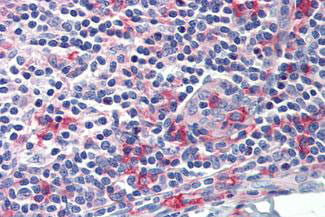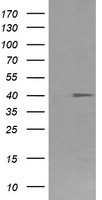FCGR1A / CD64 Antibody (clone 3D3)
Mouse Monoclonal Antibody
- SPECIFICATION
- CITATIONS
- PROTOCOLS
- BACKGROUND

Application
| WB, IHC-P, IF |
|---|---|
| Primary Accession | P12314 |
| Other Accession | 2209 |
| Reactivity | Human |
| Host | Mouse |
| Clonality | Monoclonal |
| Isotype | IgG1 |
| Clone Names | 3D3 |
| Calculated MW | 42632 Da |
| Dilution | IF (1:100), IHC-P (10 µg/ml), WB (1:4000), |
| Gene ID | 2209 |
|---|---|
| Other Names | FCGR1A, CD64A, CD64, CD64 antigen, FCG1, FcgammaRIa, IGFR1, IgG Fc receptor I, Fc-gamma receptor I A1, Fc-gamma RIA, FCGR1, Fc gamma receptor, Fc-gamma RI, FCRI |
| Target/Specificity | Human CD64 |
| Reconstitution & Storage | PBS, pH 7.3, 1% BSA, 50% glycerol, 0.02% sodium azide. Store at -20°C. Minimize freezing and thawing. |
| Precautions | FCGR1A / CD64 Antibody (clone 3D3) is for research use only and not for use in diagnostic or therapeutic procedures. |
| Name | FCGR1A |
|---|---|
| Synonyms | FCG1, FCGR1, IGFR1 |
| Function | High affinity receptor for the Fc region of immunoglobulins gamma. Functions in both innate and adaptive immune responses. Mediates IgG effector functions on monocytes triggering antibody-dependent cellular cytotoxicity (ADCC) of virus-infected cells. |
| Cellular Location | Cell membrane; Single-pass type I membrane protein Note=Stabilized at the cell membrane through interaction with FCER1G |
| Tissue Location | Monocyte/macrophage specific. |
| Volume | 50 µl |

Thousands of laboratories across the world have published research that depended on the performance of antibodies from Abcepta to advance their research. Check out links to articles that cite our products in major peer-reviewed journals, organized by research category.
info@abcepta.com, and receive a free "I Love Antibodies" mug.
Provided below are standard protocols that you may find useful for product applications.
Background
High affinity receptor for the Fc region of immunoglobulins gamma. Functions in both innate and adaptive immune responses.
References
Allen J.M.,et al.Nucleic Acids Res. 16:11824-11824(1988).
Allen J.M.,et al.Science 243:378-381(1989).
Porges A.J.,et al.J. Clin. Invest. 90:2102-2109(1992).
Benech P.D.,et al.J. Exp. Med. 176:1115-1123(1992).
Gregory S.G.,et al.Nature 441:315-321(2006).
If you have used an Abcepta product and would like to share how it has performed, please click on the "Submit Review" button and provide the requested information. Our staff will examine and post your review and contact you if needed.
If you have any additional inquiries please email technical services at tech@abcepta.com.













 Foundational characteristics of cancer include proliferation, angiogenesis, migration, evasion of apoptosis, and cellular immortality. Find key markers for these cellular processes and antibodies to detect them.
Foundational characteristics of cancer include proliferation, angiogenesis, migration, evasion of apoptosis, and cellular immortality. Find key markers for these cellular processes and antibodies to detect them. The SUMOplot™ Analysis Program predicts and scores sumoylation sites in your protein. SUMOylation is a post-translational modification involved in various cellular processes, such as nuclear-cytosolic transport, transcriptional regulation, apoptosis, protein stability, response to stress, and progression through the cell cycle.
The SUMOplot™ Analysis Program predicts and scores sumoylation sites in your protein. SUMOylation is a post-translational modification involved in various cellular processes, such as nuclear-cytosolic transport, transcriptional regulation, apoptosis, protein stability, response to stress, and progression through the cell cycle. The Autophagy Receptor Motif Plotter predicts and scores autophagy receptor binding sites in your protein. Identifying proteins connected to this pathway is critical to understanding the role of autophagy in physiological as well as pathological processes such as development, differentiation, neurodegenerative diseases, stress, infection, and cancer.
The Autophagy Receptor Motif Plotter predicts and scores autophagy receptor binding sites in your protein. Identifying proteins connected to this pathway is critical to understanding the role of autophagy in physiological as well as pathological processes such as development, differentiation, neurodegenerative diseases, stress, infection, and cancer.




